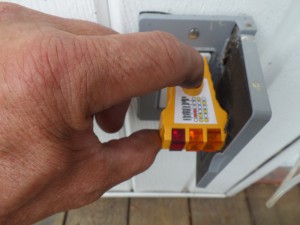Hot Reverse Electrical Outlet – During a recent House Inspection, my electrical outlet tester found an exterior outlet on a patio deck indicating “HOT REVERSE”, an electrician should look at this immediately. This has the potential to cause shock / harm / even death to anyone using this outlet.
Reversed polarity electrical receptacles:
The hot and neutral wires must be connected to the proper terminals on the electrical receptacle.
Black wire “hot” or “live”(or red wire) should be connected to the brass-colored screw terminal on the electrical receptacle, usually marked BLACK or HOT.
White wire “neutral” should be connected to the silver-colored screw terminal on the electrical receptacle, usually marked NEUTRAL or WHITE
The white wire, i.e. the neutral wire, will be connected through the receptacle’s internal parts to the wide slot on the receptacle face in order to assure that the neutral wire side of an appliance being plugged-in there is properly connected.
Why do you think wall plugs and electrical receptacles are ‘polarized’ or designed with a wide plug blade slot and a narrow plug blade slot (and on many devices a ground connector too) so that the plug will only go into the receptacle one way?” Given that there is extra cost and trouble involved, surely that’s not for “no reason”!
Which Wall Plug Blades Connect to Which Receptacle Slots?
Note that the neutral blade on a wall plug is the wider blade, plugs into the wider slot in the electrical receptacle, and is intended to connect electrically to the neutral wire inside the receptacle.
The more narrow wall plug blade on a polarized plug is the “hot” blade and is intended to connect electrically to the hot or live terminal in the electrical receptacle.
What Happens When Polarity is Reversed at a Receptacle?
Most electrical appliances and devices are designed so that their “on-off” switch interrupts electrical power at the point of entry into the appliance or device circuitry or components. If you switch the hot and neutral wires that may not quite be the case, and parts of the device will remain energized or potentially energized even when the electrical device switch is OFF. No electrical current may flow, but it could flow if someone touches the wrong part of the device, or damage may be caused.
Reversed polarity on an electrical outlet is dangerous. If you accidentally reverse these wires the device you plug in to the receptacle may “work” but it is unsafe and risks a short circuit, shock, or fire.
While some devices such as an incandescent electric light may appear to work properly and safely regardless of which way the lamp’s plug is inserted into the wall outlet, virtually all modern electrical appliances, even lamps, use polarized plugs. In the case of an electric light, the device will “work” properly in either position.
When a lamp or light fixture is connected with proper polarity, the hot wire connects to a contact at the bottom inside center of the bulb socket or screw-in base, and the neutral wire is connected to the shell that contacts the sides of the bulb when it is inserted and screwed into the socket.
But if the lamp is plugged in with its polarity reversed the metal “shell” into which the bulb screws is energized or “hot”. Because this component is much easier to touch when changing a light bulb than is the connector in the internal center of the bulb base, a shock hazard is present.
Some appliances and electronic devices may be damaged if polarity is reversed
Some appliances and some electronic equipment may be damaged if left connected to a reversed-polarity electrical circuit.
The presence of live voltage at the “wrong end” of a circuit or circuit board may cause some devices on the board to remain energized even when the device has been “switched off”. A result can be overheating or electrical shock hazards.
Common Causes of Reversed Electrical Polarity on 120V Circuits, Devices, Appliances in Buildings
The black wire was connected to the silver screw (wrong), and white wire to the brass screw (wrong) where one or more individual electrical receptacles is wired.
The black and white wires were reversed at a splice in a junction box somewhere in the circuit between the electrical panel and the first receptacle in the string, or between two downstream receptacles in the same circuit.
The black and white wires were improperly connected in the electrical panel
In an older electrical circuit it is no longer easy to visually determine which wire is “black” and which is “white”. It’s easy enough to determine which is the hot wire, using an electrical tester, neon tester, VOM or DMM, by checking for voltage or current flow between an individual wire and ground.

